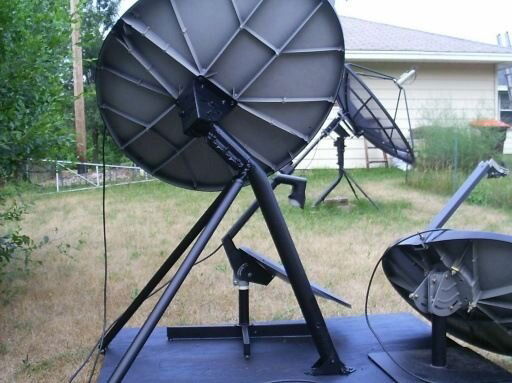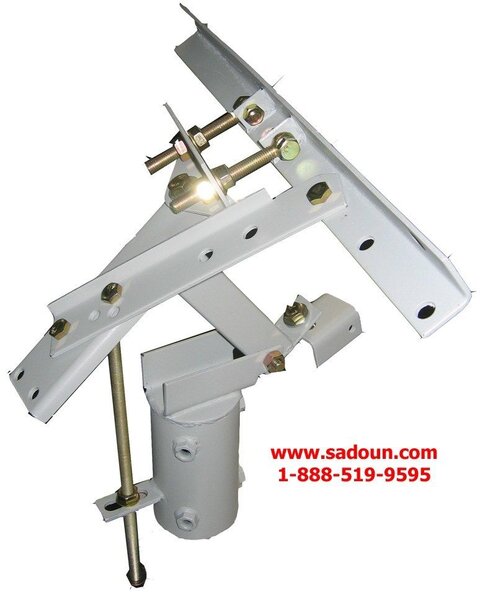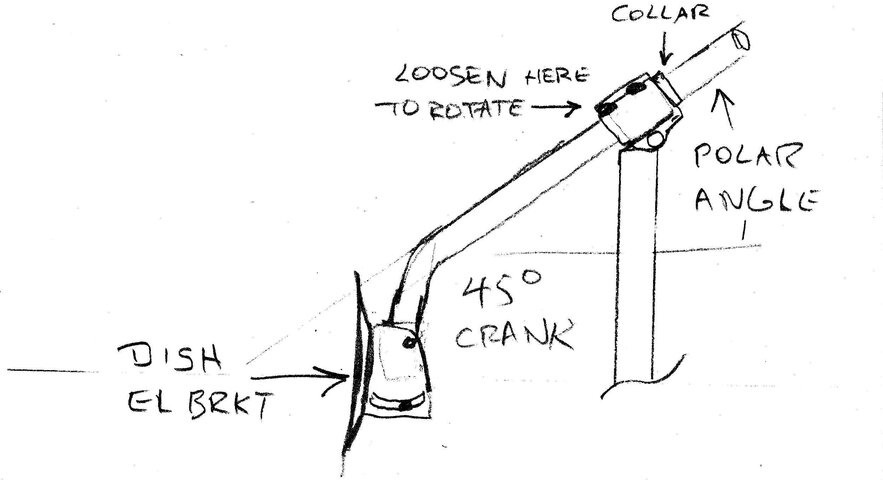Does anyone know of an adjustable polar mount (off the shelf or home design) for those of us who don't want to motorize? Such a mount would make it easier to take a peak at the arc to see what's available and maybe give slightly better performance for offset dishes.
Non-motorized Polar Mount?
- Thread starter elder
- Start date
- Latest activity Latest activity:
- Replies 20
- Views 4K
You are using an out of date browser. It may not display this or other websites correctly.
You should upgrade or use an alternative browser.
You should upgrade or use an alternative browser.
- Status
- Please reply by conversation.
This picture was posted several years ago. *
Note that the top of the post is tilted back (north) by the same angle as your latitude.
The dish is then aimed down to where the birds are on the arc.
So, once the post is aligned for both north, and tilt angle, all you have to do is loosen one bit of hardware, and swing the dish left/right to sweep through all the satellites.
* Now, when I archive interesting pix from the forum, I put them in a folder so I know who posted, and I can return to their thread for more info.
Unfortunately, when I first began collecting pictures, I didn't do that, so I can't give credit to the original author.
Note that the top of the post is tilted back (north) by the same angle as your latitude.
The dish is then aimed down to where the birds are on the arc.
So, once the post is aligned for both north, and tilt angle, all you have to do is loosen one bit of hardware, and swing the dish left/right to sweep through all the satellites.
* Now, when I archive interesting pix from the forum, I put them in a folder so I know who posted, and I can return to their thread for more info.
Unfortunately, when I first began collecting pictures, I didn't do that, so I can't give credit to the original author.
Attachments
I can't see the link that woodheat/nooil posted due to software problems, but that pic that Anole posted was definitely posted by PBS. He used to be a member hear but not anymore. I tried to find the link ,but I am unable to. Follow Anoles instuctions, tilt mast to angle of your lattitude, and point top of pole to north (north star). Once you set elevation on any sat to get get best quality, you just loosen the azimuth bolts on the dish and rotate to get best signal on any bird. It works the same idea as a motorized dish, but you need to manually move the dish from sat to sat. You never have to ajust elevation or skew in this setup once it is locked onto any sat, just azimuth.
BUDs, mini-BUDs, micro-BUDs:
Yes, it was a series of Ku-related pictures by member PSB.
He was a moderator, and quite a character. Search his name for old threads!
Here is another example post of his, using a C-band LNBF on the inclined support to track the arc.
http://www.satelliteguys.us/free-air-fta-discussion/39119-40-c-ku-band-dish-4.html#post305225
Oh, and for all you mini-bud followers, look at the date on the post: 2005 !
Yes, SatGuy members have been at it for a LONG time - it's nothing new.
BUD: starting at 6 feet / 1.8 meters, and up
mini-BUD: starting at 4 feet / 1.2 meters, and on up to BUD size
micro-BUD: pretty much anything up to mini-bud size.
Guess I'm beginning to take too much for granted.
Yes, it was a series of Ku-related pictures by member PSB.
He was a moderator, and quite a character. Search his name for old threads!
Here is another example post of his, using a C-band LNBF on the inclined support to track the arc.
http://www.satelliteguys.us/free-air-fta-discussion/39119-40-c-ku-band-dish-4.html#post305225
Oh, and for all you mini-bud followers, look at the date on the post: 2005 !
Yes, SatGuy members have been at it for a LONG time - it's nothing new.
BUD: starting at 6 feet / 1.8 meters, and up
mini-BUD: starting at 4 feet / 1.2 meters, and on up to BUD size
micro-BUD: pretty much anything up to mini-bud size.
That was the best part, and I completely forgot to mention it.You never have to adjust elevation or skew in this setup once it is locked onto any sat, just azimuth.
Guess I'm beginning to take too much for granted.
Here is the link to PSB's picture shown in anole's post, see post #5:
http://www.satelliteguys.us/free-air-fta-discussion/77348-dish-when-its-extremes.html
Bob
http://www.satelliteguys.us/free-air-fta-discussion/77348-dish-when-its-extremes.html
Bob
The extremes thread is a great one, if my earlier search had found it I wouldn't have asked my Az El vs Polar question a while back. All my questions seem to be answered except possibly whether it's best to compensate for my 24.62 degree dish offset at the polar axis angle or with the dish elevation adjustment.
Does anyone know of an adjustable polar mount (off the shelf or home design) for those of us who don't want to motorize? Such a mount would make it easier to take a peak at the arc to see what's available and maybe give slightly better performance for offset dishes.
I had a spun aluminum no-name 6ft C- band dish in 1983, that had a hand-cranked polar mount. It basically consisted of regular 1" x 1" angle iron, and a long threaded rod with a hand-crank on the end of it. Very simple, and very accurate once I got the declination set, and the polar angle. There were a lot less sats back then, so once I figured out where they were, I would simply count the number of turns from one sat to the next. Worked for me, and I enjoyed it.
So, they are out there, and it shouldn't be hard to duplicate a design such as that.
Set you mast to match your latitude and then leave it alone. Do your dish elevation to adjust for elevation.....whether it's best to compensate for my 24.62 degree dish offset at the polar axis angle or with the dish elevation adjustment.
Bob
Last edited:
My Geosat Pro 90cm dish mount won't go below 10 degrees elevation so I guess I'll turn the dish upside down to achieve the declination offset which is 5.64 for my latitude.Set you mast to match your latitude and then leave it alone. Do you dish elevation to adjust for elevation.
Bob
I haven't done it, but:
Let me think about this for a second.
I believe if you get the pole tilted true north...
- corrected for local magnetic variation...
- and at the exact angle of your latitude...
- then all that's left is to adjust the dish's elevation for any bird, and you'll be on the arc.
(Start out on your True South satellite)
Same rules apply as to setting up a motor.
If you're high on one end of the arc and low on the other, your pole isn't exactly north.
If you're high on both ends of the arc, or low on both ends of the arc, then the angle of your pole is incorrect.
Tweak it up or down a degree, then readjust the elevation on the dish to restore your True South bird, and try again.
I -think- that's about all there is to it...
Did I miss anything?
And for the same reason.
Let me think about this for a second.
I believe if you get the pole tilted true north...
- corrected for local magnetic variation...
- and at the exact angle of your latitude...
- then all that's left is to adjust the dish's elevation for any bird, and you'll be on the arc.
(Start out on your True South satellite)
Same rules apply as to setting up a motor.
If you're high on one end of the arc and low on the other, your pole isn't exactly north.
If you're high on both ends of the arc, or low on both ends of the arc, then the angle of your pole is incorrect.
Tweak it up or down a degree, then readjust the elevation on the dish to restore your True South bird, and try again.
I -think- that's about all there is to it...
Did I miss anything?
Yea, that's what PSB did on his Ku experiments.My Geosat Pro 90cm dish mount won't go below 10 degrees elevation so I guess I'll turn the dish upside down ...
And for the same reason.
One could bolt in a trailer jack with a hand crank....quite a common item that could easily be placed on an existing polar mount.
Is this what you are looking for?
We use it on the Fortec 180cm prime focus dish
Can that mount be purchased separately or is it only bundled with a dish?
If I mount the dish upside down it appears that I will still have a problem, the beam would be 10 degrees below horizon with no range to elevate it.My Geosat Pro 90cm dish mount won't go below 10 degrees elevation so I guess I'll turn the dish upside down to achieve the declination offset which is 5.64 for my latitude.
I was musing over what to do with the J-tube from my defunct SkyAngel dish and this idea struck me. Picture the J-tube mounted to the post with a clamp (see illustration) that can be adjusted for polar angle plus be loosened for rotation. If the 45 degree crank is too much for my dish's el adjustment to be in the range for declination adjustment it could be sprung open a few degrees. Some sort of an hour angle scale could be added behind the clamp. The collar shown above the clamp would keep the tube from slipping down when the clamp is loosened for rotation. I suspect a support bracket between the post and the polar axis would have to be added for stability.
Comments?
Comments?
Attachments
I was wondering what all the confusion was about.All my questions seem to be answered except possibly whether it's best to compensate for my 24.62 degree dish offset at the polar axis angle or with the dish elevation adjustment.
I think this is the root.
The angle of the top of your pole is not negotiable.
It is your latitude.
The down-tilt of the dish to see the Clarke Belt is accomplished with the elevation mount on the dish, just like it is on the little H-H motors.
The problem with most dish mounts, is that they cannot go -25° to account for the 25° up-look of the dish.
On a Plumb Pole:
When set for +25° in normal operation, the dish would be vertical due to its up-look.
If you could just spin the dish 180° so the LNB was at the top, without changing any other settings, the dish would still be vertical but looking down 25°.
edit: removed erroneous reference to skew plate.
In operation, it needs to look down about 5°, so tilt the dish up toward the sky 20°.
Now it looks down 5°.
Tilt the pole back the 35° (or whatever) of your latitude (depends on where you are), and you are getting close.
I feel the above is confusing, but if you pick your way through it, perhaps you'll find a light at the end of the tunnel.
Last edited:
Is this what you are looking for?
We use it on the Fortec 180cm prime focus dish
Can that mount be purchased separately or is it only bundled with a dish?
Can that mount be purchased separately or is it only bundled with a dish?
Right now it is only available with a bundled dish.
Last edited:
- Status
- Please reply by conversation.
Similar threads
- Replies
- 4
- Views
- 703
- Replies
- 15
- Views
- 569
- Replies
- 1
- Views
- 809
- Replies
- 21
- Views
- 2K




